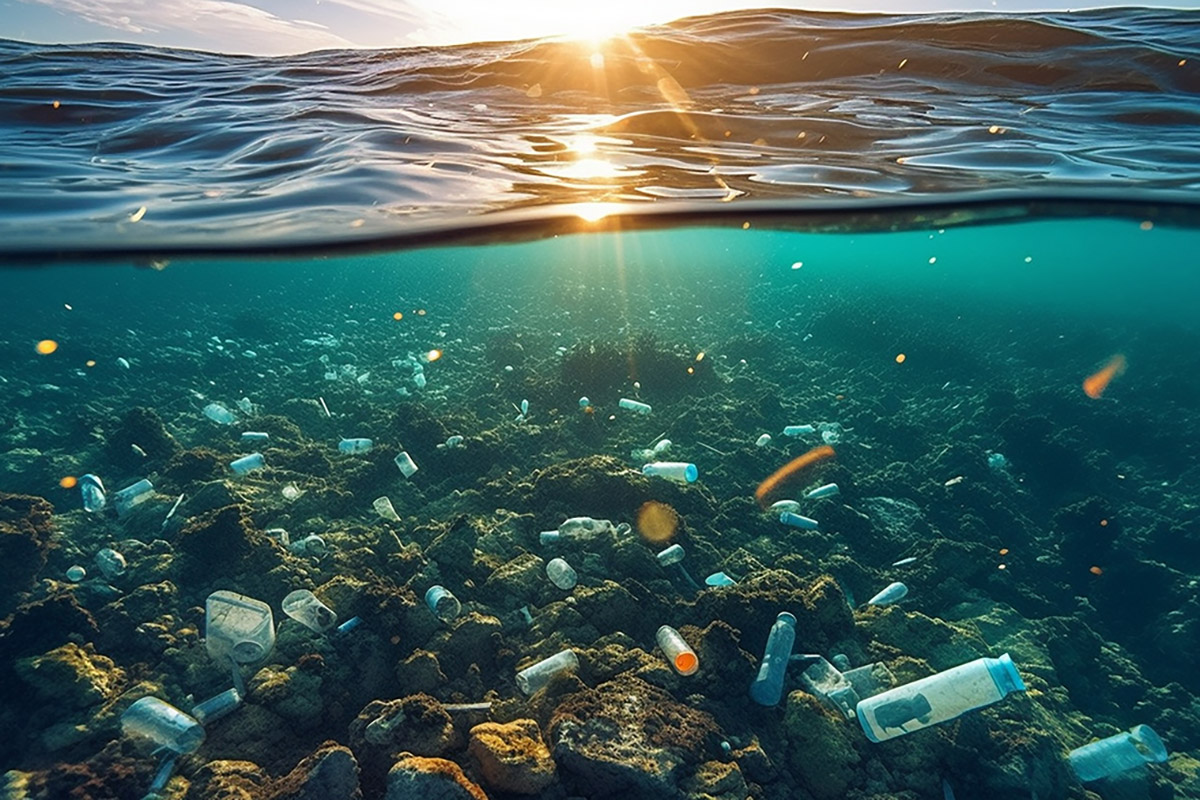How Concerned Should I Be About Microplastics?

Right now, more than 51 trillion microplastic particles are estimated to litter the world’s seas, a quantity that outnumbers the stars in our galaxy by 500 times.
As such, microplastics have fast become one of humanity’s most pressing environmental issues, with two-thirds of all plastic ever produced said to still remain on the earth in the form of microplastics.
These minuscule fragments of plastic linger everywhere in our environment, with vast quantities found floating in oceans, hidden in the furthest reaches of the planet and in the stomachs of marine and land animals.
Now researchers are beginning to question the effect that plastic pollution has on human health after a report commissioned by the WWF found that the average person eats the equivalent of a credit card’s worth of plastic in just one week.

What exactly are microplastics?
Microplastics are tiny pieces of plastic – smaller than 5mm in size – that are grouped into two categories: primary and secondary microplastics.
Primary microplastics are created for commercial use, like the tiny beads used in exfoliating face scrubs and toothpastes. Secondary microplastics come from larger pieces of plastic such as bags, bottles and fishing nets that fragment into small pieces over time.
The term microplastics was coined back in the early 2000s, when marine scientist Richard Thompson stumbled upon small bits of plastic, about the size of rice grains, on a beach in England. As time has gone on, researchers have discovered millions more of these tiny plastic pieces all around the world – from deep in the Mariana Trench’s ocean floor to the top of Mount Everest.
Recently, there’s been a new area of study focusing on ‘nanoplastics.’ These are even tinier bits of plastic – so small they’re not visible to the naked eye or even under a microscope. There’s mounting concern about plastic pollution getting even smaller, with scientists racing to understand the potential impacts of these super tiny plastic particles on our health and environment.
Why are people concerned about microplastics?
The concern around microplastics is mainly down to their potential impact on both the environment and human health. These small particles are so tiny that they can easily enter our ecosystems, including oceans, rivers, and soil. Studies have found that when marine life, like fish and shellfish, ingests microplastics, the particles can move up the food chain to humans.
According to research published in the Journal Environmental Science and Technology, the average person is estimated to ingest around 50,000 microplastic particles a year through food and drink, with traces found in everyday items like cow’s milk and water.
While research is ongoing, some studies suggest that these microplastics could carry harmful chemicals and toxins, with the potential for long-term health consequences.

How concerned should we be?
Breathing in or consuming these particles might have negative health implications, but the full extent of the risks is not yet fully understood.
One recent study from 2021 looked at tiny microplastics in the human placenta, finding that they carry endocrine disruptors – substances that can interfere with the normal functioning of the endocrine system in humans and animals. Previous studies have found that endocrine disruption can lead to various health problems, including developmental, reproductive and immune system issues, and even certain types of cancer.
The 2021 placenta study concluded that exposure to microplastics during pregnancy could potentially contribute to adverse outcomes like preeclampsia and fetal growth restriction.
Nevertheless, due to the scarcity of conclusive studies on microplastics in humans, their long-term health impacts remain somewhat inconclusive. Ongoing research aims to delve deeper into how these particles might interact with the human body, whether they can release harmful chemicals, and whether they might lead to long-term health concerns.
Research centered on the impacts of microplastics on aquatic life, especially fish and seabirds, has yielded more findings. Numerous research papers have highlighted how the ingestion of plastic particles can trigger large-scale mortality among marine creatures. And an additional study from the Galway-Mayo Institute of Technology found that fish exposed to microplastics exhibit symptoms including energy depletion, fertility complications, and, in some extreme cases, premature death.
Unfortunately, there just isn’t enough concrete evidence to say for sure whether microplastics are a danger to humans, as more peer-reviewed scientific research is needed.
However, given the potential risks to both the environment and human health, it’s wise to take the concern seriously.

What can I do to reduce my microplastic exposure?
It’s nearly impossible to avoid microplastics, but there are some steps we can take to limit spreading and ingesting them.
Choose natural fibres
Where possible, choose clothing made from natural fibres like cotton, wool, or silk. These materials shed fewer microfibers in the washing machine compared to synthetic fabrics. Shop second-hand or look for fashion brands that are B Corp certified, as these retailers support ethical, sustainable practices and transparent business operations right through the supply chain.
Avoid single-use plastics
Reduce your use of single-use plastic items like plastic bags and bottles. By using reusable alternatives, you can help cut down on secondary plastic waste that degrades into smaller particles. It only takes a few times of bringing your own thermos mug to your local coffee shop before it becomes a habit.
Use a microfiber filter
Consider using a microfiber filter in your washing machine. These easy-to-fit filters can help capture microfibers before they enter the water system, saving an estimated bag’s worth of plastic from entering the oceans each week.
Recycle your plastics
Make sure to properly recycle and dispose of plastic waste you accrue. This helps prevent larger plastics from breaking down into microplastics over time.
Support cleanup efforts
Finally, it’s never too late to get into local plastic clean-up initiatives. Whether you participate in an organised beach or river clean-up effort, or simply collect errant plastic on your daily walk, sorting and recycling collected litter can keep harmful plastics out of landfill.


















